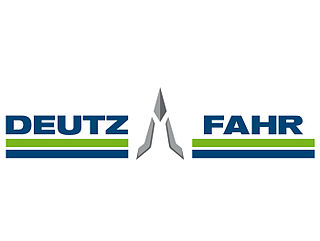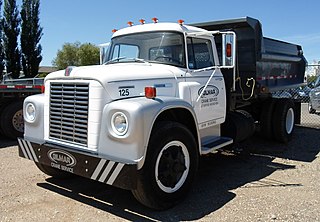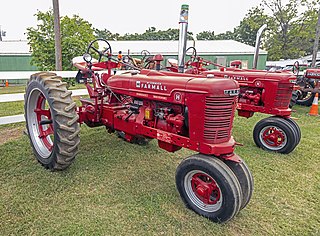
Massey Ferguson Limited is an American agricultural machinery manufacturer. The company was established in 1953 through the merger of farm equipment makers Massey-Harris of Canada and the Ferguson Company of the United Kingdom. It was based in Toronto, then Brantford, Ontario, Canada, until 1988. The company transferred its headquarters in 1991 to Buffalo, New York, U.S. before it was acquired by AGCO, the new owner of its former competitor Allis-Chalmers. Massey Ferguson is among several brands in a portfolio produced and marketed by American industrial agricultural equipment conglomerate AGCO and a major seller in international markets around the world.

The Piper PA-24 Comanche is an American four-seat or six-seat, low-wing, all-metal, light aircraft of semimonocoque construction with tricycle retractable landing gear. Piper Aircraft designed and developed the Comanche, which first flew on May 24, 1956. Together with the PA-30 and PA-39 Twin Comanches, it made up the core of the Piper Aircraft lineup until the production lines for both aircraft were destroyed in the 1972 Lock Haven flood.

The International Harvester Company was an American manufacturer of agricultural and construction equipment, automobiles, commercial trucks, lawn and garden products, household equipment, and more. It was formed from the 1902 merger of McCormick Harvesting Machine Company and Deering Harvester Company and three smaller manufactures: Milwaukee; Plano; and Warder, Bushnell, and Glessner. In the 1980s all divisions were sold off except for International Trucks, which changed its parent company name to Navistar International. Its brands included McCormick, Deering, and later McCormick-Deering, as well as International. Along with the Farmall and Cub Cadet tractors, International was also known for the Scout and Travelall vehicle nameplates.

The Piper PA-32R is a six-seat, high-performance, single engined, all-metal, fixed-wing aircraft produced by Piper Aircraft of Vero Beach, Florida. The design began life as the Piper Lance, a retractable-gear version of the Piper Cherokee Six. Later models became known by the designation Piper Saratoga. The primary difference between the Lance and early Saratoga is the development of a tapered wing on the Saratoga, replacing the "Hershey bar" wing on the Lance that was a carryover from the Cherokee Six. Later Saratoga models provided updated/improved avionics, engine and interior touches but retained the same airframe design.

Farmall was a model name and later a brand name for tractors manufactured by International Harvester (IH), an American truck, tractor, and construction equipment company. The Farmall name was usually presented as McCormick-Deering Farmall and later McCormick Farmall in the evolving brand architecture of IH.

The Hughes TH-55 Osage is a piston-powered light training helicopter produced for the United States Army. It was also produced as the Model 269 family of light utility helicopters, some of which were marketed as the Model 300. The Model 300C was produced and further developed by Schweizer after 1983.

Deutz-Fahr is a German agricultural machinery manufacturer. It was established in 1968 after the acquisition of the majority of share capital in FAHR, a leading company already producing agricultural equipment in the previous century, by the Klockner-Humboldt-Deutz AG (KHD) group. In 1995 Deutz-Fahr joined the Italian Group SAME/Lamborghini/Hürlimann to become the SAME Deutz-Fahr Group, now the SDF Group.

CLAAS is an agricultural machinery manufacturer based in Harsewinkel, Germany, in the federal state of North Rhine Westphalia. Founded in 1913 by August Claas, CLAAS is a family business and one of the market and technology leaders in harvesting technology. It is the European market leader in combine harvesters and considered as world market leader in self-propelled forage harvesters. The product range also includes tractors, balers, mowers, rakes, tedders, silage trailers, wheel loaders, telehandlers and other harvesting equipment as well as farming information technology. CLAAS employs around 11,500 employees worldwide and reported a turnover of roughly 3.9 billion euros in the 2019 financial year. About 78.5% of sales are generated outside of Germany.

The Turbomeca Marboré is a small turbojet engine that was produced by Turbomeca from the 1950s into the 1970s. The most popular uses of this engine were in the Fouga CM.170 Magister and the Morane-Saulnier MS.760 Paris. It was also licensed for production in the United States as the Teledyne CAE J69.
The Perkins 4.236 is a diesel engine manufactured by Perkins Engines. First produced in 1964,over 70,000 were produced in the first three years, and production increased to 60,000 units per annum. The engine was both innovative and reliable, becoming a worldwide sales success over several decades.

The International Loadstar is a series of trucks that were produced by International Harvester from 1962 to 1978. The first product line of the company developed specifically as a medium-duty truck, the Loadstar was slotted between C-Line pickup trucks and the heavy-duty R-series. Following the discontinuation of the R-series, the Loadstar was slotted below the Fleetstar and Transtar conventionals.

The Blohm & Voss Ha 140 was a German multi-purpose seaplane first flown in 1937. It was intended for use as a torpedo bomber or long-range reconnaissance aircraft but did not enter production.
The bus chassis variant of the International S series is a cowled bus chassis that was produced by International Harvester from 1979 to 2001. Produced primarily for school bus applications, the chassis was also produced for other applications, including commercial-use buses and cutaway-cab buses. In addition, the cowled chassis formed the basis for front-engine and rear-engine stripped chassis produced for bus applications.

Claas Lexion is a series of combine harvesters, manufactured by Claas in Harsewinkel. An American version called Lexion was produced by Claas Omaha Inc. in the United States.

The Farmall H is a medium-sized two-plow row crop tractor produced by International Harvester under the Farmall brand from 1939 to 1954. It was the most widely produced of International Harvester's "letter series", with approximately 390,000 produced over the 14-year run. It succeeded the Farmall F-20. The H was incrementally updated with new model numbers as the Super H, 300, and 350, but remained essentially the same machine. The original H used an International Harvester C152 4-cylinder in-line engine. Production of all versions lasted until 1963.
The Selbstfahrer is the first self-propelled combine harvester by Claas. In total, 19.465 units were produced from 1952 to 1963. The German name Selbstfahrer literally means Self-propeller and in the German agricultural language, it refers to a combine harvester or agricultural machine that can propel itself. Initially, the name of the Selbstfahrer was Hercules; due to an already registered trademark with the name Hercules, the combine harvester was renamed SF for Selbstfahrer in 1953. In contemporary brochures, the Selbstfahrer is called Claas Selbstfahrer Type S.F.55. It was targeted at agricultural contractors and large farms in Europe. In 1961, the Selbstfahrer was succeeded by the Matador. However, it was kept in production until 1963.

The Mercator is a series of combine harvesters produced by the German agricultural company Claas in Harsewinkel. Initially called Senator, the Mercator series was introduced in 1966. The first combine harvester of the series to be called Mercator was presented in 1967, the Protector followed in 1968. Both are less productive but also less expensive models. With the Facelift, the Senator was renamed Mercator 70, while the Protector models were given the names Mercator 60 and 50. Later, more models of the Mercator series were introduced, such as the Mercator 75.

The Fortschritt E 516 is a self-propelled combine harvester made by VEB Mähdrescherwerk Boschofswerda/Singwitz. It was developed in the late 1960s and first half of the 1970s, and after extensive testing in 1975, it was put into series production in 1977. In 1983, the E 516's second generation, the Fortschritt E 516 B was introduced. It was discontinued in 1988 in favour of its successor, the Fortschritt E 517.

The S-4 «Stalinets», is a self-propelled combine harvester, made by several different combine harvester plants in the former Soviet Union, from 1947 until 1955. In 1955, the modernised variant, called the S-4M, was introduced; it was put out of production in 1958. In total, 29,582 units were built. In former East Germany, the S-4 combine was built under licence by the IFA as the Fortschritt E 170 series, from 1954 until 1967. Unlike the original S-4, which is powered by an otto engine, the Fortschritt E 170 series combines were all powered by a diesel engine, and some of them came with a chaff waggon rather than a straw waggon.

The Fortschritt E 512 is a self-propelled combine harvester that was made by the East-German manufacturer VEB Mähdrescherwerk Bischofswerda/Singwitz, and sold under the Fortschritt brand. It is the first Fortschritt combine harvester that has been solely developed in the GDR. The E 512 succeeded the Fortschritt E 170 series. At the time of its introduction in the late 1960s, the E 512 was a modern, sought-after combine harvester that could compete well with high-performance combines made in Western countries, such as the Clayson 140 and the Claas Senator. In total, 51,412 units were made from 1968 until 1988, which makes the E 512 the East German combine harvester with the highest production figure.

















